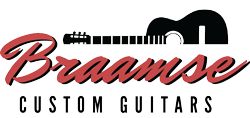Guitar number 1 is not a perfect instrument. The body is a little too thin, the action is a little too high, and the sunburst finish was not by design, but to cover a potentially devastating mistake. Nonetheless, guitar number 1 is beautiful. Guitar number 1 helped me to discover my passion and showed me that I may have a knack for this whole guitar building thing.
The idea to build my first guitar started about a year before I actually attempted the project. I had been playing the guitar for only a couple years at this time (I self taught myself in college). I was talking with my father about guitars in general. I had an entry level Martin dreadnought at the time and was explaining to him how I wish it had a cutaway and was a little smaller. I told him I really wanted a Taylor guitar. In passing, he said, “You know, it might be cool to build one someday.” The conversation ended there and I went back to finish college.

Soon after I graduated, my dad’s comment came back to me and I decided to look into actually building a guitar. I bought the excellent book, “INSERT BOOK NAME HERE”, read through a couple blogs I found online about building guitars, researched what I would need to accomplish the task, ordered the parts and soon began the project.
Keep reading to see how my first attempt turned out.
This is how it all started. Not having a workshop or many tools, I am not able to do the guitar 100% from scratch. Some key components I had serviced for me were sides being bent roughly to the shape, the top and back pieces being joined, and the neck being partially carved. The neck being partially carved had more to do with I was not confident I could do it myself, as at first, this was the most intimidating step of the whole process.


One of the most important things to do right away is to make sure the bent sides do not go back to their more natural and straight position. In this picture, you can see the sides are placed in a mold to hold shape. I made some pretty high tech clamping devices to press the sides against the sides of the mold.
In this picture, you can see I’m clamping down some of the top braces (sound bars). I’m using fiberglass rods as clamps. The top and back of my guitars are radiused, so many of these sound bars are sanded to that radius. I have the guitar top inside a radiused dish, while clamping the braces. Once all of the braces are glued on, the top and back of the guitar will be slightly curved.


Each sound bar is tuned to a specific note. This is probably the most important step in determining the overall sound of the guitar. Leave too much material on the top, and the guitar will sound dull and flat. Take too much off, and the top will be too weak to withstand the tension from the strings and could end up cracking. In this picture, you can see all of the braces on the top. I sprayed a light coat of finish to protect the braces. I have it taped off so I do not get finish where I will glue the top to the sides.
In this picture, I’m gluing the kerfing onto the sides of the guitar. Kerfing is used to attach the sides of the guitar to the top and bottom. It is a structural element that increases the surface area at the glue joint and provides a little bit of support.


Here, you can see the kerfing installed.
The guitar is starting to come together! In this picture, I am gluing the top to the sides. I’m using the same radiused dish I used earlier, so that I am clamping everything down to the final guitar radius.


The body of the guitar is nearly complete. The mold is finally off and it is really starting to take shape.
Below, you can see the binding being installed. The channel first needs to be routed, then the binding is glued in place. Finally, after the glue is dried, the binding is planed flush with the body.




I decided to take a small risk and with 0 experience in inlaying, wanted to inlay my initials into the headstock. I cut the letters out of mother of pearl and used a router base attachment for my dremel. I was very pleased with the results. Inlaying is much easier than you would think! Just takes patience.



With the construction of the guitar complete, the time has come to apply the finish. I used epoxy to fill the grain and then experimented with a wipe on instrument varnish. Overall, I was pleased with the results, but I will probably not use a varnish again.
Not every part of the guitar gets finished, so I taped off where I didn’t want any finish.

